Creative Scholarship News
Array of research topics, high turnout mark 2025 Research Symposium, as nearly 70 projects receive awards for studies on cancer, social media, robotics and more
With projects focused on cancer treatments, social media influence, robotics innovations and more, the 2025 Auburn Research Symposium spotlighted the research and creative scholarship of nearly 500 graduate and undergraduate students from Auburn University and Auburn University at Montgomery. The symposium was held March 26 at the Melton Student Center, and 69 award-winning presenters were honored during an April 2 ceremony.
For the second year running, postdoctoral researchers participated in non-competitive presentations, as well as in newly added round-table discussions. Turnout was high for the annual event, with a near 10% increase in the number of presenters.
“It was a genuine pleasure to witness the outstanding presentations at this year’s symposium,” said Lorenzo Cremaschi, symposium organizing committee chair and director of undergraduate research. “All our students and postdoctoral researchers did an exceptional job in showcasing their research and emphasizing its impact. I extend my heartfelt thanks to all the participants who presented, judged and organized the symposium, and I offer my sincerest congratulations to the award recipients for their remarkable achievements.”
Cremaschi noted, “This event not only serves as an excellent platform to share the remarkable research conducted at Auburn but also fosters collaboration and networking both within and beyond the university. Connecting with peers, sharing ideas and building partnerships can lead to groundbreaking discoveries and innovations that benefit both the academic community and society at large.”
Undergraduate research awards
The undergraduate first-place award in the Science, Technology, Engineering and Mathematics poster presentations went to Nathan Newman of the Department of Pathobiology in the College of Veterinary Medicine, who won the same award the previous year. Matthew Hughes, from the Department of Poultry Science in the College of Agriculture, received first place in the STEM oral presentations.
In the category for Human Sciences, Social Sciences, Creative Arts, Nursing and Humanities, Toni Lee of the Department of Sociology, Anthropology and Social Work in the College of Liberal Arts won first place in the poster division, and Leticia Raymundi Pinheiro of the College of Nursing took first in the oral presentations.
Graduate research awards
The graduate student first-place winner for the Science, Technology, Engineering and Mathematics poster presentations was Mana Okudaira of the Department of Clinical Sciences in the College of Veterinary Medicine. The winner of the first-place award in the STEM oral presentations was Jaden King of the College of Forestry, Wildlife and Environment.
In the category for Human Sciences, Social Sciences, Creative Arts, Nursing and Humanities, Zeynep Su Altinoz of the Department of Human Development and Family Science (HDFS) in the College of Human Sciences won first place in the poster presentations. Emma Chandler, also of HDFS, received first-place recognition in the oral presentations.

Categories: Creative Scholarship, Undergraduate Research, Graduate Student Research
Auburn materials engineering students have MXene research down to a fine art
At this rate, Auburn may need to open its own "NanoArt" museum. Because the Department of Materials Engineering just keeps churning out masterpieces.
The latest award-winning contribution comes, once again, courtesy of microscope maestro Yeonjin Baek, one of the department's most recent doctoral graduates, and rising star of the so-called NanoArt competition circuit created by engineers and scientists celebrating the surprisingly artistic aspects of their research. Her medium? Once again, MXenes — a still relatively new class of 2D conductive crystalline nanomaterials promising battery storage breakthroughs, like giving your iPhone a full-day's charge in seconds or supplying juice to supercapacitors for millions of charging cycles.
Otherworldly images mined from MXenes have quickly become go-to graphics for NanoArt competitions since they were discovered at Drexel University in 2011; it turns out that, combined with a little Photoshop creativity, the results of throwing slices of, say, vanadium carbide under scanning electron microscopes (SEMs) can be downright stunning.
A year ago, Baek took home the grand prize in Japanese research technology company JEOL's annual scanning SEM image contest for a scan of a synthesized Vanadium oxide nano structure. Imagine a bouquet of flowers painted by impressionist Édouard Manet, but with the nearly unfathomable resolution of the materials engineering department's $500,000 JEOL JSM-7000F SEM).
Months later, her "MXene T-Rex," a scan of a layered niobium carbide resembling a Tyrannosaurus Rex 10 times smaller than the width of a human hair, won the October round of the same contest. Most recently — and, in terms of reflecting Auburn's rising materials engineering preeminence, perhaps most impressively — it placed second out of 300 submissions from 29 countries in the 9th annual NanoArtography competition sponsored by Purdue University's School of Materials Engineering and Drexel University's Nanomaterials Institute.
"I believe that materials engineering is essential for driving technological progress," said Baek, who recently accepted a postdoctoral research position at the University of Arizona. "What fascinates me most is how we can manipulate materials at the micro and nanoscale to innovate and improve various devices like electric vehicles and batteries.
"When we synthesize materials, they often appear as nothing more than dark gray or black powders. However, when observed under a microscope, we can uncover beautiful layered structures or unique nanoscale patterns. Materials like MXenes exhibit delicate accordion-like layered structures that make them particularly ideal for NanoArt. These structures showcase the texture and beauty of the nanoscale, providing a perfect canvas for creative interpretations."
Thanks the Department of Materials Engineering, Auburn's reputation for creative interpreations of the nanoscale has been at macro proportions for years.
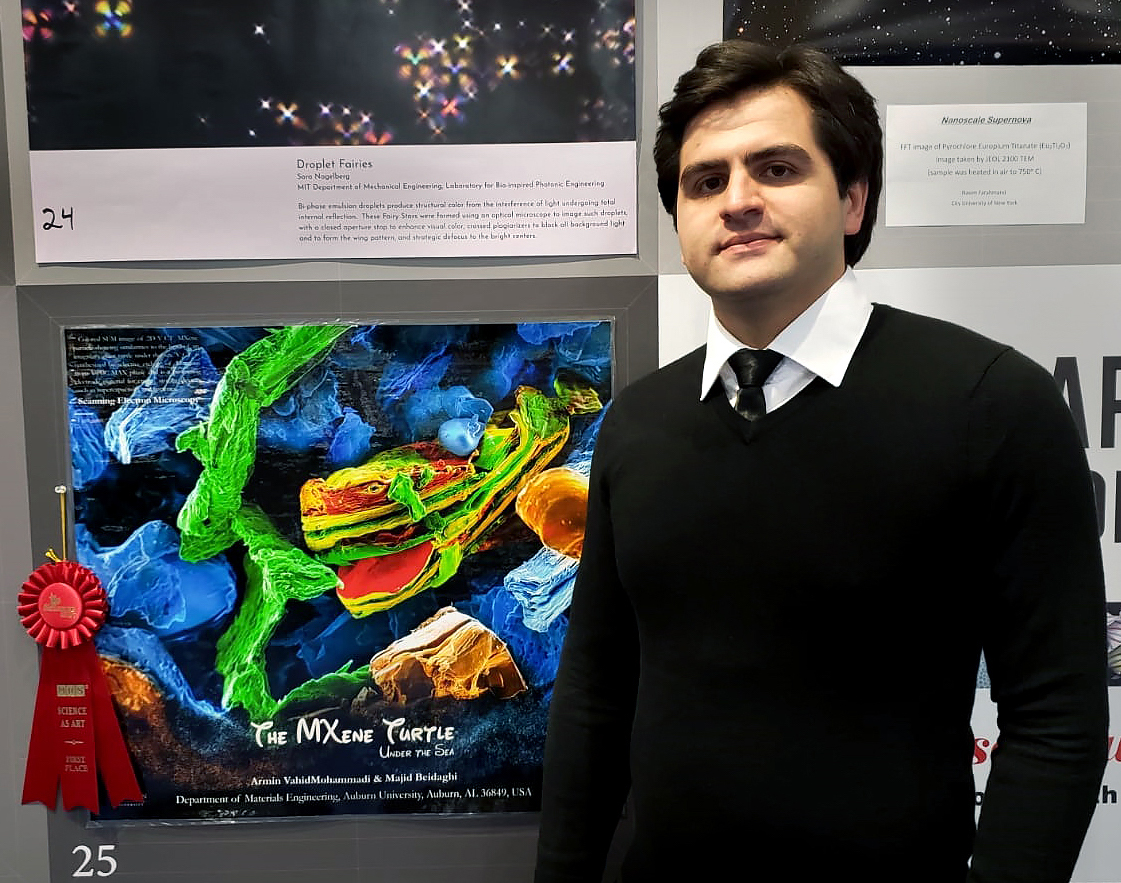
Armin VahidMohammadi poses with "The MXene Turtle Under the Sea," which won First Place in the 2018 MRS Science as Art competition.
Baek was actually Auburn's second grand prize winner in the JEOL contest. In 2017, materials engineering doctoral student Armin VahidMohammadi, who is now in product development at Tesla, snagged the blue ribbon with "Nano Nemo on the Water," a scan of a MXene designated Ti2C modified to resemble a clown fish. It was his second conquest in an epic string of victories that gained attention even outside the scientific community for primarily playing on pop culture.

A year before he found Nemo in titanium carbide, the avid Harry Potter fan's wildly vivid "Nano Lord Voldemort" placed first in the Materials Research Society’s Science as Art competition, an accomplishment repeated in 2018 after spotting "The MXene Turtle Under the Sea" in clouds of vanadium carbide. For his 2019 entry, he again used the force of the material engineering department's JSM-7000F to produce "MXene Yoda," a scan of oxidized 2-D V2CTx particles.
Win again, he did.

"It's been great for our students to receive this sort of attention for their creativity," said materials engineering program chair Bart Prorok, Baek's faculty advisor. "But I'd like to think it also reflects rather favorably on the research our department excels in. Right now a lot of that research is, obviously, in MXenes.
And, right now, Auburn students obviously have that research down to a fine art.
"While Armin was here, his research on MXenes was featured in Advanced Materials, which is a pretty prestigious journal," Prorok said. "But even though you could look at the nano artwork as a kind of novelty, thousands of materials scientists pay attention to a lot of these competitions. So, the artwork he and now Yeonjin have done has definitely helped us gain attention on our research, and it's attention I think Auburn deserves."
Media Contact: Jeremy D Henderson, jdh0123@auburn.edu, 334-844-3591

Yeonjin Baek poses in front of a display of "Flower Power," which won the grand prize in JEOL'S 2023 SEM Image Contest.

Yeonjin Baek's, "MXene T-Rex," a scan of a layered niobium carbide resembling a Tyrannosaurus Rex 10 times smaller than the width of a human hair
Categories: Creative Scholarship, Engineering
Abstract submission for 2025 Auburn Research Symposium now open
Abstract submission for the 2025 Auburn Research Symposium is now open and will close on Feb. 10, 2025. Undergraduate students, graduate students and post-doctoral researchers in a multitude of disciplines are invited to participate through oral presentations, posters and creative scholarship displays.
The event will be held Wednesday, March 26, in the Auburn University Melton Student Center. Registration details, abstract guidelines and presentation award criteria are posted on the Research Symposium website.

Categories: Creative Scholarship, Undergraduate Research, Graduate Student Research
SHOWCASE 2025 to highlight creative scholarship at Auburn; submissions deadline extended to 4:45 p.m. on October 7, 2024
For the first time since its triennial schedule was interrupted by the COVID-19 pandemic after the 2018 event, Auburn University will host another SHOWCASE event during spring semester 2025.
SHOWCASE 2025 will bring together creative scholarship from across the university and will center around advocacy and process, featuring both completed works and works in process as a way of highlighting the resources necessary for the creation and elevation of creative scholarship.
Submitted work must be finished and have been completed within the previous three years; discussion of process work will occur in panels and workshops that will be announced closer to Spring 2025.
All types of creative scholarship may be submitted, including, but not limited to physical artifacts and live performances. Interdisciplinary and/or collaborative work is also welcome. The deadline for submissions has been extended to 4:45 p.m. on October 7, 2024, and full submission information is available at showcase.auburn.edu.
Entries will be exhibited in locations such as the Jule Collins Smith Museum of Fine Art, the Gogue Performing Arts Center and other locations around campus.
The theme of SHOWCASE 2025 is “advocacy” for creative scholarship at Auburn that is supported through three goals: visibility of creative scholarship and the arts across campus and the community, collaboration across different colleges and schools, and alignment of creative scholarship within the university’s strategic mission and goals.
“Creative scholarship at Auburn has a rich history and an even brighter future as we move into this new technological era,” said Dr. Anna Ruth Gatlin, Assistant Professor and Internship Coordinator in the Department of Consumer Design Sciences. She is a member of the executive committee coordinating the event along with Dr. Chase Bringardner, Associate Provost, and Robert Finkel, Program Chair and Associate Professor of Graphic Design. The three represent, respectively, the College of Human Sciences, the College of Liberal Arts and the College of Architecture, Design and Construction.
“Creative scholars can think about problems and solutions in unexpected ways, and often creative scholarship outputs can be easily disseminated to the public, involving the community, which is part of the university’s strategic goals,” Gatlin concluded. “We’re excited to spearhead this process of advocating for creative scholarship at Auburn.”

SHOWCASE 2025 will center around advocacy and process, with submissions due September 30, 2024.
Categories: Creative Scholarship
Submissions sought for 2025 SHOWCASE creative scholarship event
SHOWCASE brings together creative scholarship from across the university and offers our communities opportunities to engage in that work. SHOWCASE 2025 specifically centers on advocacy and process, showcasing both completed works and works in process as way of highlighting the resources necessary for the creation and elevation of creative scholarship.
We are seeking proposals of creative scholarship produced by faculty and students across all fields at Auburn University. All types of creative works are embraced for submission, including, but not limited to physical artifacts and live performances. Interdisciplinary and/or collaborative work is welcomed. Visit the SHOWCASE webpage to learn more.
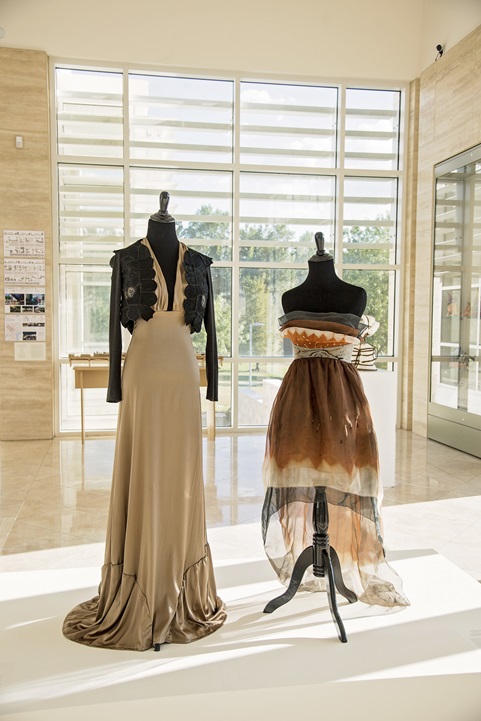
Categories: Creative Scholarship
Abstract submission now open for the 2024 Auburn Research Symposium
Abstract submission for the 2024 Auburn Research Symposium is now open and will close on Feb. 11, 2024. Undergraduate and graduate students are invited to participate through oral presentations, posters and creative scholarship displays. Postdoctoral researchers are also invited to participate through oral presentations featured during the symposium.
The event will be held on Tuesday, March 26, in the Auburn University Melton Student Center. Registration details, abstract guidelines and best presentations award criteria are posted on the Research Symposium website.
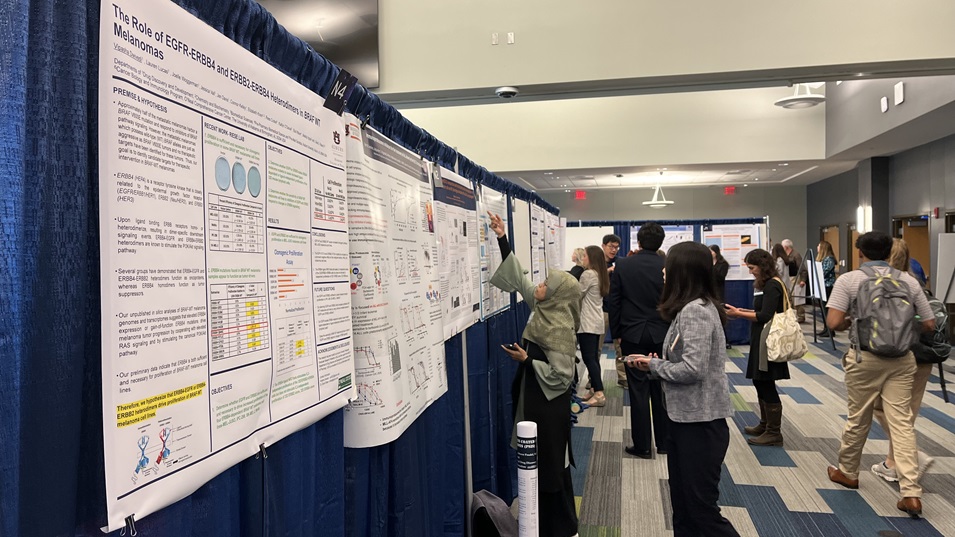
Categories: Creative Scholarship, Undergraduate Research, Graduate Student Research
Student research symposium posters viewable on RBD Library digital wall
Posters from the 2023 Auburn Research Student Symposium are currently displayed on the digital wall in the Innovation and Research Commons of the Ralph Brown Draughon Library. The symposium is an annual spring event that shares student research and creative scholarship with a broad audience consisting of faculty, staff, graduate and undergraduate students and the public.
The Digital Wall is located on the first floor of the Ralph Brown Draughon Library and is available for viewing during all regular library hours.
More information about the Auburn Research Student Symposium. More information about the Digital Wall.
Categories: Creative Scholarship, Undergraduate Research, Graduate Student Research
Sixty-four students win awards at ‘Auburn Research: Student Symposium’
Sixty-four students took home awards for their research and creative scholarship posters and oral presentations during the recent “Auburn Research: Student Symposium.” Nearly 440 undergraduate and graduate students from Auburn University’s main campus and Auburn University at Montgomery participated in the annual symposium, which gives students an opportunity to share their work university-wide and with the general public.
“Congratulations to the award winners and to all of the students who participated,” said Lorenzo Cremaschi, director of undergraduate research. “Everyone did an outstanding job presenting their remarkable projects. Auburn has a wealth of talented student researchers.”
Undergraduate research awards
The undergraduate first-place award in the Science, Technology, Engineering and Mathematics poster presentations went to Alicia Taylor of Chemistry and Biochemistry. Catherine Walls of Poultry Science captured first place in the STEM oral presentations.
In the category for Human Sciences, Social Sciences, Creative Arts, Nursing and Humanities, Haley Shufflebarger of Interior Design won first place for her poster presentation, while Jordan Windham of Political Science took first in the oral presentations.
Graduate research awards
The graduate student first-place winner for the Science, Technology, Engineering and Mathematics poster presentations was Arthur Lamounier Moura of Forestry and Wildlife Sciences, while first place in the STEM oral presentations went to Claudia Rutland of Crop, Soil and Environmental Sciences.
In the category for Human Sciences, Social Sciences, Creative Arts, Nursing and Humanities, Sydney Waitz-Kulda of Psychology won first place in the poster presentations, while Priyadarshni Patel of Nutrition, Dietetics and Hospitality Management captured first in the oral presentations.
College-specific awards were also presented for undergraduate and graduate student categories. A complete list of winners, as well as titles of their projects, is available on the “Auburn Research: Student Symposium” website.
The Ralph Brown Draughon Library also plans an exhibit showcasing many of the winning posters. Details will be announced later about the exhibit.
BY CHARLES MARTIN
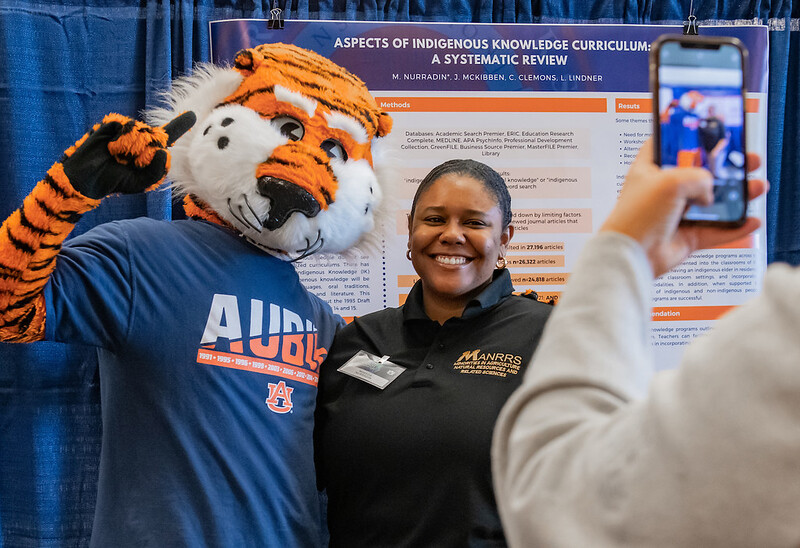
Aubie visits with Auburn student Makeda Nurradin of Curriculum and Teaching, who won third place in the graduate student poster presentations in the category, Human Sciences, Social Sciences, Creative Arts, Nursing and Humanities. Sixty-four students took home awards on the university and college levels.
Categories: Creative Scholarship, Undergraduate Research, Graduate Student Research
Building Science, Architecture faculty digitally preserving Alabama’s disappearing Rosenwald Schools
In the early decades of the 1900s when racial segregation was the norm, almost 400 schools were built in rural Alabama to serve as educational facilities for African American children.
These were known as the Rosenwald Schools and, between 1912-32, they made it possible for African American children to obtain a formal education in a time when doing so would otherwise be nearly an impossibility.
Today, these schools are quickly fading, and a team of researchers from Auburn University’s College of Architecture, Design and Construction is working to digitally preserve and bring attention to the disappearing Rosenwald Schools. Funded by grants from their college, the university’s inaugural Creative Work and Social Impact Scholarship Funding Program and the McWhorter Fund for Excellence, Junshan Liu, Bob Aderholdt Endowed associate professor in the McWhorter School of Building Science, and Gorham Bird, visiting assistant professor in the School of Architecture, Planning and Landscape Architecture, have begun their initial work to digitally document and re-construct four of these schools.
Using the latest digital documentation technology, their end product includes digital Building Information Models, or BIMs, 3D-printed physical models, as-built drawings and online virtual tours of these historic buildings. Their work will be presented through exhibitions to engage the public in civil rights history, teach emerging technologies and promote historical preservation.
“We started last summer,” Bird said. “It is now approaching 100 years since many of these schools were built. It is estimated that 10-12 percent of the original schools remain. Most are falling apart, and there is a pressing need to document and preserve them before they are gone.”
According to the research team, the first six schools in Alabama were built in Lee, Macon and Montgomery counties. The first Rosenwald School was built in Loachapoka in 1914.
In 1917, Julius Rosenwald expanded the project and established the Rosenwald Fund to oversee the establishment of new rural schools. Until 1920, the projects were managed by Tuskegee Institute and designed by Tuskegee architecture faculty Robert R. Taylor and W.A. Hazel. Starting in 1920, management of new schools was taken on by an independent Rosenwald Fund office located in Nashville, Tennessee, and the design of the schools became the responsibility of Samuel L. Smith, a white architect.
“Historic preservation has always been a part of my academic interest,” Bird said. “These schools advanced rural African American education beyond any other system, and they have maintained an impressive community impact. In fact, some alumni still hold reunions to this day.
“Economists have attributed the Rosenwald Schools for creating the African American middle class. Despite the inequities that existed in the Jim Crow South, the remaining Rosenwald Schools serve as a testament to the self-determination and resilience of the communities that worked to build them. This legacy cannot be lost to time.”
Liu leads the digital effort of the project using drones, LiDAR scanners—a system that uses laser to capture dimensional data of an object—360-degree photography, photogrammetry and other digital-based technologies to document and develop intelligent BIM models of these structures.
“We will ultimately create a digital and physical archive of these schools as historic sites that can be shared through exhibits to teach students and others,” Liu said.
Working with partners at the Alabama Historical Commission, or AHC, the project team has identified four Rosenwald Schools in Alabama for this initial work.
The four Alabama schools are geographically diverse, include different models of building type, and condition. The team plans to use this sample of schools to test and perfect the approach for documentation and presentation, in anticipation of seeking more external funds to map, document and preserve the remaining schools in the state and the South.
“The AHC has long wanted to document the remaining Rosenwald Schools,” Bird said. “This project is very much in line with their goals.”
The team has identified sites that are on the National Register of Historic Places that include:
- New Hope School, Chambers County, 1915. One-teacher school type;
- Mount Sinai School, Autauga County, 1919. Two-teacher school type;
- Oak Grove School, Hale County, 1921. Two-teacher school type;
- Tankersley School, Montgomery County, 1922. Three-teacher school type.
“The benefits of this workflow include the expedience of documentation and level of detail and accuracy,” Liu adds. “These benefits allow for a greater number of Rosenwald Schools to be digitally recorded in a shorter period of time with a very high degree of quality.”
The research team has completed a pilot test of documentation through a field survey of one of the Rosenwald Schools, the New Hope School in Chambers County. Three-dimensional LiDAR scanning and aerial photogrammetry was used to develop a digital 3D BIM.
The team also has uncovered archival materials, including the original design documents, through interviews with the president of the New Hope Foundation. An example virtual tour of the Tankersley Rosenwald School in Montgomery County illustrates the pressing need for intervention and preservation of these schools.
The project’s first phase including all four schools is expected to be completed in spring 2023, Bird said.
BY MITCH EMMONS

The New Hope School in Chambers County is one of 400 Rosenwald Schools built between 1912-32 to serve as educational facilities for African American children. A team of Auburn University professors from the College of Architecture, Design and Construction is working to digitally preserve and bring attention to the disappearing schools.
Categories: Creative Scholarship, External Engagement
New Auburn University internal awards programs name winners for 2021
Auburn University launched two new pilot internal awards programs in 2021 and has named the program’s first recipients.
The Research Support Program, or RSP, and the Creative Work and Social Impact Scholarship Funding Program, or CWSI, were established by the Office of the Vice President for Research and Economic Development. Both programs provide a competitive internal funding source to support faculty and to provide an opportunity for them to experience a small-scale pilot and refine their projects before competing for larger awards.
“This is a pilot version of a larger intramural award program,” said Bob Holm, associate director of Proposal Services and Faculty Support, the unit that administers the programs. “It enables faculty to participate in a competitive funding program and make improvements to their projects before a commitment to a long-term award program is made. The pilot provides a platform to test what works and what does not.”
The RSP is intended to be an annual cycle funding program to foster the development and growth of innovative and transformational research activities. It builds on faculty expertise, stimulates interdisciplinary collaborations and strengthens seed research activities. It is a strategically focused Auburn investment that promotes promising and impactful new lines of research as well as the growth of collaborative and interdisciplinary teams to build the foundations of science, to overcome scientific and societal challenges and to promote and enhance the quality of life and wellbeing of individuals, groups and communities.
The CWSIS funding program fosters innovation and discovery and builds faculty reputation and competitiveness. Examples of prestigious recognition for CWSIS include: the McArthur Genius Award, the Gates Foundation Award, appointment to the National Council on the Humanities or the National Council on the Arts and an NSF Senior Advisor for Public Access. Disciplines associated with CWSIS include design and the arts, humanities and applicable areas within business, education, social sciences and health and well-being.
As a form of research, creative work poses questions and searches for the answers through iterative processes that demand intellectual rigor and hard work. Related scholarship narrates, analyzes and evaluates the production and products of creative work, or proposes new and innovative approaches to that work, including interdisciplinary collaborations and explorations. The goals of creative work and scholarship are ultimately tied to making significant contributions to a meaningful and dignified quality of life.
Social impact scholarship involves research that is specifically aimed at societal challenges and values both theoretical and applied domains to produce core knowledge and address persistent and complex issues to create a better world and improve the lives of all individuals. Research in this domain often engages a diversity of stakeholders with the goal of bringing beneficial effects and valuable changes to the economy, society, education, public policy, health and quality of life.
This year’s recipients are:
Research Support Program
Brian Albanese, College of Liberal Arts, $24,999.34; “Neurobehavioral sensitivity to negative reinforcement in suicide”;
Benjamin Bush, College of Architecture, Design and Construction, $24,987; “EX4C: Next Generation Blood and Vaccine Transport for Combat, Austere and Challenging Environments”; co-investigators: Lorenzo Cremaschi, Samuel Ginn College of Engineering; Joellen Sefton, College of Education; David Crumbley, School of Nursing;
Nathaniel Hardy, College of Agriculture, $25,000, “The Evolution of Virulence in Xylella fastidiosa”; co-investigator: Leonardo De La Fuente, College of Agriculture;
Amal Khalil Kaddoumi, Harrison School of Pharmacy, $25,000; “Amylin role in Alzheimer’s disease”; Co-Investigator: Ahmed Hamid, College of Sciences and Mathematics;
Peng Li, Samuel Ginn College of Engineering, $25,000, “Probing Novel Quantum Phases in van der Waals Magnet Fe5GeTe2”; co-investigators: Masoud Mahjouri-Samani, Samuel Ginn College of Engineering; Wencan Jin, College of Sciences and Mathematics;
Panagiotis Mistriotis, Samuel Ginn College of Engineering, $25,000; “Bioengineering tools to uncover the mechanisms of human mesenchymal stem cell migration”;
Kristina Neely, College of Education, $25,000; “Inhibitory Motor Control in Adults with ADHD,” co-investigator: William Murrah, College of Education;
Janna Willoughby, School of Forestry and Wildlife Sciences, $24,998; “How do environmental and genetic effects interact to determine individual fitness?”; co-investigators: Avril Harder, School of Forestry and Wildlife Sciences; Lana Narine, School of Forestry and Wildlife Sciences; Kelly Dunning, School of Forestry and Wildlife Sciences.
Creative Work and Social Impact Scholarship Funding Program
Junshan Liu, College of Architecture, Design and Construction, $20,000; “Digitally Preserving and Re-presenting Alabama’s Rosenwald Schools”; co-investigators: Gorham Bird, College of Architecture, Design and Construction; Richard Burt, College of Architecture, Design and Construction;
Alicia Powers, College of Human Sciences, $19,191.92; “A clinical-community pediatric wellness initiative to manage and prevent cardiometabolic diseases in children with limited resources in Alabama”; co-investigators: Jeanna Sewell, Harrison School of Pharmacy; Felicia Tuggle, College of Liberal Arts, Sarah Watts, School of Nursing.
More information about these and other funding support programs supported by the AU Office of the Vice President for Research and Economic Development can be found by clicking here.
BY MITCH EMMONS
Categories: Creative Scholarship, Energy & the Environment, Health Sciences, Food Systems, Engineering, External Engagement, OVPRED, Life Sciences, Agriculture
Rural Studio making strides, enjoying exciting developments through Front Porch Initiative
Auburn University’s Rural Studio and its Front Porch Initiative have made great contributions to several communities in the Southeast thus far in 2021.
By partnering with affordable housing providers throughout the region, the Front Porch Initiative has been able to support the completion of several houses and the groundbreaking for others since February. All totaled, nine homes are or will soon be under construction through the Rural Studio program, which features homes designed by College of Architecture, Design and Construction, or CADC, students enrolled in the School of Architecture, Planning and Landscape Architecture, or APLA.
These homes are the result of partnerships with housing providers in the Southeast who leverage the applied research and prototype home designs developed through Rural Studio’s ongoing teaching and research with the technical assistance offered by the Front Porch. The initiative leadership includes principal investigator Rusty Smith, associate director of Rural Studio and an APLA faculty member, and co-principal investigators Mackenzie Stagg and Elizabeth Farrell Garcia, assistant research professors.
“In 1993, Rural Studio began by designing and constructing a single home for one family in rural west Alabama,” Smith said. “Acting almost on instinct, we knew then that access to safe and affordable home ownership might be the key to unlocking prosperity in under-resourced communities. Now almost 30 years later, the research is unequivocal: having equitable access to healthy, efficient and durable housing is one of the most powerful social determinants of health. Leveraging this power of home ownership, Rural Studio’s Front Porch Initiative brings together the best housing products, partnerships, practices and policies necessary to provide opportunity and advance equitable outcome throughout the Southeast and in the communities and families that need it most.”
The Front Porch Initiative is a program of Auburn’s Rural Studio, an off-campus design-build program in the School of Architecture, Planning and Landscape Architecture that has been educating citizen architects in Hale County, Alabama, since 1993. The initiative—whose mission is to promote equitable access to affordable, dignified, energy-efficient, resilient and healthy housing—is supported through Rural Studio’s partnership with Fannie Mae.
Front Porch partner Affordable Housing Resources, or AHR, in Nashville was the first collaborator to break ground and complete a collection of four new homes. With estimated mortgage payments of $900 a month, the new homes align with AHR’s mission is to provide affordable housing to Nashville residents.
The Chipola Area Habitat for Humanity, or CAHFH, broke ground on a pair of Rural Studio-designed homes in Jackson County, Florida, on Feb. 25, with two more in the planning stages. Construction of the homes is bolstered through a new partnership with the Building Construction Technology Program at Chipola College that enables students enrolled in the program to earn class credits in exchange for building the CAHFH homes.
On May 7, the Florida project took a big step forward thanks to CAHFH’s Women Build event, which brought out a group of approximately 50 women from the region. Stagg represented Rural Studio on the special day, which saw builders frame the interior and exterior walls of one home, install hurricane straps to another and air seal the home to increase energy efficiency.
“The work with Chipola Area Habitat for Humanity and Chipola College is an exciting collaboration that unites our shared resources in order to increase equitable housing access, facilitate continued disaster recovery efforts and grow a skilled workforce that is prepared to build back better and mitigate damage from potential future weather events,” Stagg said. “It has been a rewarding experience to see how many pieces of the complex housing system have started to come together.”
Certified Community Housing Development Organization Eastern Eight CDC, or E8CDC, is partnering with Front Porch to build a model home to attract more interest from residents of eastern Tennessee to pursue small-unit offerings in the area. The team broke ground on the house on April 8 with representatives from Rural Studio, Appalachia Service Project—a not-for-profit builder providing home repairs and new construction—and E8CDC, which provides a range of housing services to clients in an eight-county service area.
The Front Porch Initiative currently works with organizations in Alabama, Tennessee, Florida and South Carolina. Auburn’s Rural Studio is based in Newbern, Alabama, and has a 15-year history of developing affordable, high-performance rural homes.
BY NEAL REID
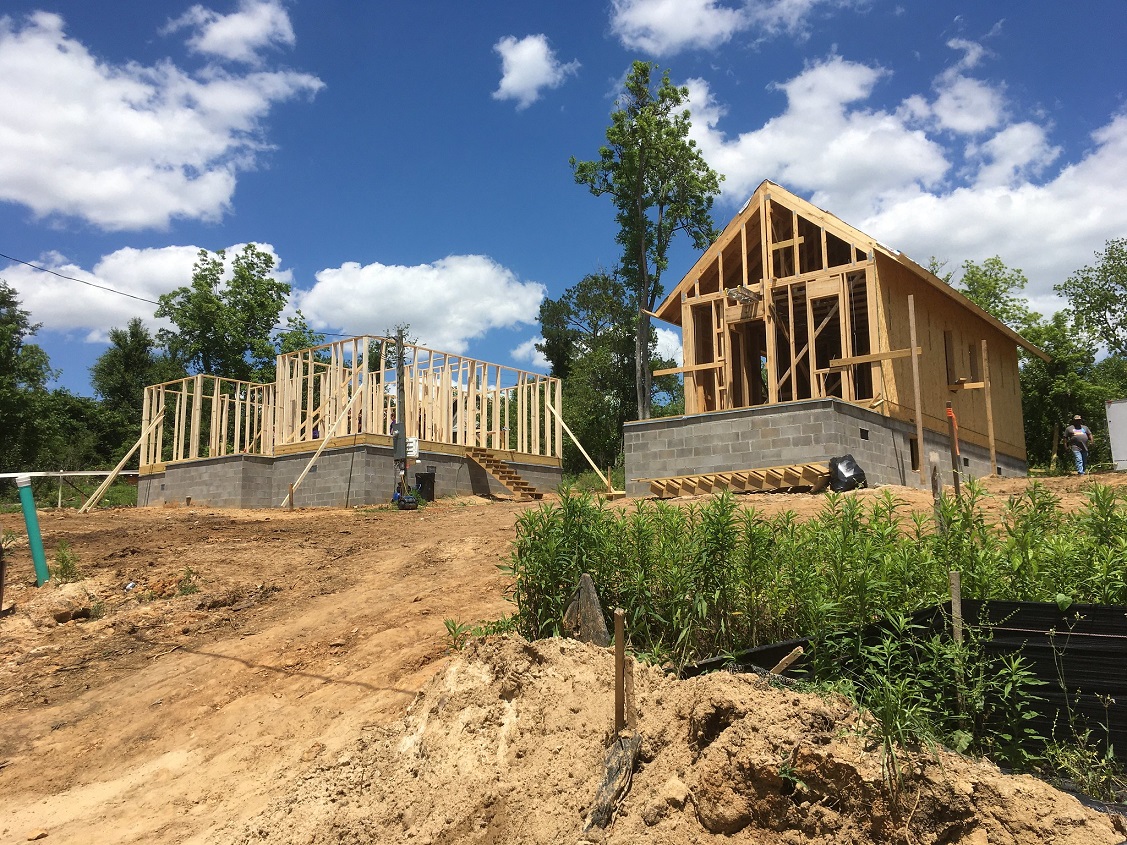
Construction progress of Front Porch Initiative homes at Chipola Street Development in Marianna, Florida. (Image by Rural Studio)
Categories: Creative Scholarship, External Engagement, Undergraduate Research
Sixty-three students win awards at ‘Auburn Research: 2021 Student Symposium’
Sixty-three students took home awards for their research and creative scholarship posters and oral presentations during the recent, virtual “Auburn Research: 2021 Student Symposium.” Nearly 350 undergraduate and graduate students from Auburn and Auburn Montgomery participated in the annual symposium, which gives students an opportunity to share their work university-wide and with the general public.
Undergraduate Research Awards
The undergraduate first-place award in the Science, Technology, Engineering and Mathematics poster presentations went to Anna Solomonik of Drug Discovery and Development. Shalom Kim of AUM Chemistry and Biochemistry captured first place in the STEM oral presentations.
In the category for Human Sciences, Social Sciences, Creative Arts, Nursing and Humanities, Sally Ann Missildine of Interior Design won first place for her poster presentation, while Stanley Wijaya of Nutrition, Dietetics and Hospitality Management took first in the oral presentations.
Graduate Research Awards
The graduate first-place winner for the Science, Technology, Engineering and Mathematics poster presentations was Manjusha Annaji of Pharmaceutical Sciences, while first place in the STEM oral presentations went to Kaelyn Fogelman of Fisheries, Aquaculture and Aquatic Sciences.
In the category for Human Sciences, Social Sciences, Creative Arts, Nursing and Humanities, Kassandra Ross of Consumer and Design Sciences won first place in the poster presentations, while Juliana Parma of Kinesiology captured first in the oral presentations.
College-specific awards were also presented for undergraduate and graduate student categories. A complete list of winners, as well as titles of their projects, is available on the “Auburn Research: 2021 Student Symposium” website.
![orange and blue background graphic: Auburn Research: A Showcase of Research and Creative Scholarship Student Symposium 2021 Virtual Event march 29-April 2 [Auburn University logo]](https://cws.auburn.edu/shared/files?id=159&filename=RSRH%20-%202021%20Student%20Research%20Symposium%20Social%20Media%20Graphics_TW.jpg)
Sixty-three students have won awards for their research presentations given during the Auburn Research: Student Symposium 2021 virtual event held March 29 through April 2.
Categories: Creative Scholarship, Health Sciences, Science, Technology, Engineering and Mathematics (STEM), OVPRED, Life Sciences, Undergraduate Research, Agriculture
Auburn Research: Student Symposium virtual event set for March 29-April 2, offers showcase of student research, creative scholarship
Although the presentation format is virtual, this year’s “Auburn Research: Student Symposium” offers Auburn University and Auburn University Montgomery students a unique venue for showcasing their research and creative scholarship to a broad audience. More than 350 student presentations are expected for the symposium, which runs March 29-April 2.
“Undergraduate and graduate students will be making oral, poster and creative scholarship presentations,” said Lorraine Wolf, director of undergraduate research and organizing member of the Auburn Research Symposia Committee. “Students from all disciplines will participate.”
This year’s event, instead of the typical live presentations, is being conducted virtually. Podium presentations will be delivered live via Zoom, with presenters assigned a specified time. Poster presentations will be prerecorded, but opportunities for feedback and interactions will be provided.
“The student symposium is envisioned as an opportunity to share student discoveries and creative scholarship with a broad audience consisting of faculty, staff, graduate and undergraduate students and the public,” Wolf said. “In addition, students can compete for several awards, with prizes ranging from $50 to $500.”
More information about the event can be found on the Auburn Research: Student Symposium website. Undergraduate students with questions should contact Wolf at undgres@auburn.edu. Graduate students should direct questions to Sara Schiller at sgs0025@auburn.edu.
“Even though we are having to conduct this year’s symposium online, it still offers students a unique opportunity for presenting their work,” Wolf said. “Despite the challenges of the past year, our students are actively involved in cutting-edge research on a broad range of socially, culturally and scientifically relevant topics, and we believe there will be substantial interest, just as in the years previous.”
BY MITCH EMMONS
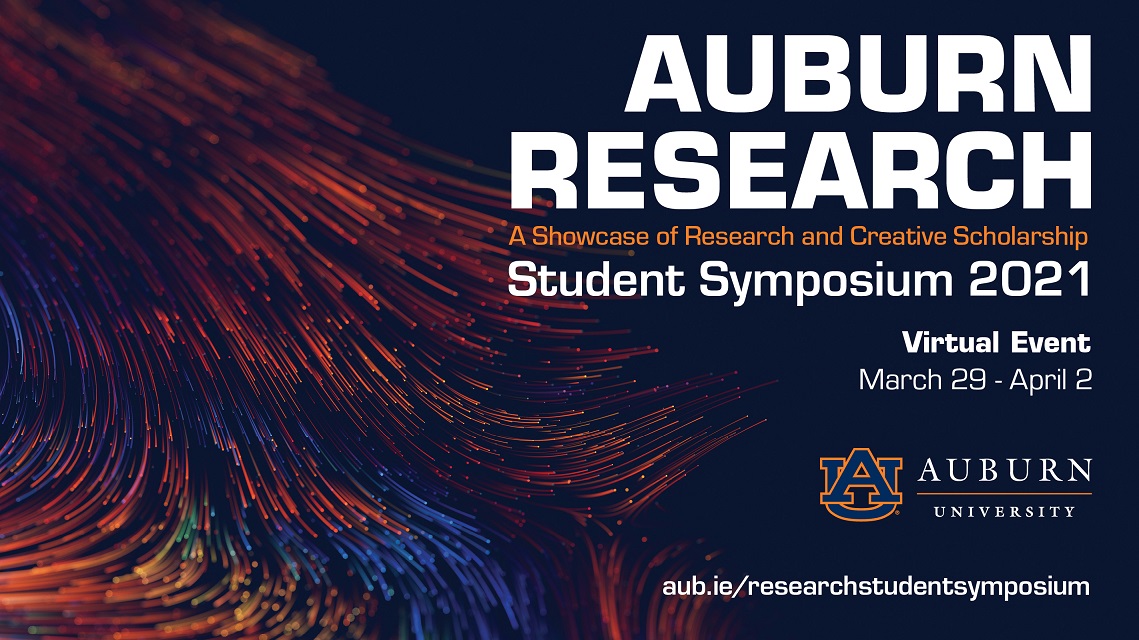 The 2021 Auburn Research: Student Symposium is set for March 29-April 2.
The 2021 Auburn Research: Student Symposium is set for March 29-April 2.
Categories: Creative Scholarship, Science, Technology, Engineering and Mathematics (STEM), Undergraduate Research
Passion project: Auburn professors joining forces to preserve historical significance of Selma’s ‘Bloody Sunday’
Interdisciplinary effort part of Auburn University’s annual Tiger Giving Day
Approaching Selma, Alabama, from the south on Highway 80, the iconic Edmund Pettus Bridge looms large on the horizon as travelers begin the incline to cross the Alabama River.
Most drivers may not notice the 300-yard area before the bridge—now a dilapidated row of mostly boarded-up businesses long since shuttered—or even realize they are traveling through a historic site until they happen to catch a glimpse of the modest memorial park located to the bridge’s southeast as they head downtown. Two Auburn University professors—Richard Burt and Keith Hébert—are committed to changing that, as the four-lane roadway that heads toward the bridge was the site of one of the most seminal moments of the history of civil rights.
That was where, on March 7, 1965, John Lewis, Hosea Williams and a group of approximately 600 marchers were confronted by Alabama State Troopers armed with tear gas and metal batons as they began a march for equality toward Montgomery. The nation watched in horror that night on ABC as marchers were pummeled by law enforcement in what became known as “Bloody Sunday,” an event that would serve as a catalyst for Americans across the country to rally behind the civil rights movement like never before.
A much larger group of marchers—including Rev. Martin Luther King Jr. and Lewis—eventually would complete the roughly 50-mile journey to the state’s capital city on March 24, but Bloody Sunday will remain a pivotal day in the annals of U.S. history. The event contributed greatly to the Voting Rights Act becoming law on Aug. 6 of that year and forever entrenched Selma in the history books.
For Burt—the McWhorter Endowed Chair and head of the McWhorter School of Building Science in the College of Architecture, Design and Construction—that stretch of highway in Selma has sparked a passion project fueled by the desire to know more about what took place on that historic day.
“We consider this one of the most important historic sites in the United States,” Burt said. “When most people think about Bloody Sunday, they think about the bridge, but the actual conflict didn’t occur on the bridge. I don’t know if visitors who drive by there really get the historic significance of this.
“It is not just important to Alabama, it’s important to the whole U.S., and everyone in the world knows about Selma, Alabama. I think this site deserves some attention to tell its story and have its history chronicled in more detail.”
In 2016, Burt and his research team—which included Danielle Wilkins, now an assistant professor at the Georgia Tech Institute of Technology—began using historical photos and video footage, photogrammetry software, laser scanners, drones and design concepts and technology to survey and map the area where the confrontation occurred. Burt’s team has been able to identify and chart the location of everything from local businesses, vehicles parked on the road and Alabama State Troopers, to the civil rights marchers, spectators and media, including the ABC News van that captured the events as they unfolded.
Burt has been able to largely recreate the scene from 1965 in the form of schematics and computerized plans in a pursuit to preserve the setting of Bloody Sunday.
“I think the power of this project is that it started off using science on the survey and architecture side and is moving to the historical aspect going forward,” Burt said. “The fact that it’s interdisciplinary and everyone is working together speaks a lot to the importance of this area and the project in general.”
Burt’s project piqued the interest of Hébert from the Department of History in the College of Liberal Arts in 2017, and the two began a partnership that gave the project added depth. Hébert echoes Burt’s sentiments regarding the significance of Bloody Sunday and the area they are researching.
“Selma is a very significant historic site, and when people all over the world hear the name Selma, Alabama, they think of human rights and voting rights,” said Hébert, an associate professor of history and public history program officer at Auburn. “The march from Selma to Montgomery in many ways is seen as one of the seminal turning points of the civil rights movement. Bloody Sunday helped generate more public support for the things the marchers were marching for, and it was a catalyst for change in getting the national opinion behind certain parts of the civil rights movement.
“People still come to Selma to look at the bridge and the monument and reflect on how far we’ve come and how far we still have to go, and the bridge is an excellent metaphor for that. This area we are researching was Ground Zero for the civil rights movement.”
Newest phase of research
Going forward, Burt, Hébert and their colleagues hope to use all the tools at their disposal to identify even more aspects of the scene in Selma on that day—most importantly the identities of the marchers. Some of the more prominent figures—including Lewis and Williams—have been identified through the years, but hundreds of other brave participants remain unrecognized.
The project has been included in the university’s annual Tiger Giving Day initiative this year, and Burt and Hébert hope to raise funds to advance the venture through 2021 and beyond and identify the hundreds of marchers. They hope to do so through an alliance with Auburn’s Honors College, whose students will be tasked to identify the individuals who were part of Bloody Sunday.
Burt and his team have worked extensively with the Alabama Department of Archives and History, as well as with other historians, media and researchers to learn what they have thus far, and Burt said plans are in the works for a grant submission to fund an archeological endeavor and a K-12 education workshop. Donations made to the project through Tiger Giving Day could be a springboard to new discoveries for the talented team, and, as a result, give credence to the group’s desire to give the historic site its just due.
“Fortunately, several years ago, the National Park Service created a historic trail that links Selma to Montgomery along Highway 80, but a lot of buildings that were there in 1965 are in need of preservation,” Hébert said. “They need to be identified, catalogued and studied so we know exactly what happened, almost minute-by-minute, during the struggle in Selma.”
Importance of preserving history
From a big-picture standpoint, chronicling and researching history is a noble pursuit in the eyes and minds of academics, especially Burt and Hébert.
“It’s not an understatement to say that history is power,” Hébert said. “How we remember the past has meaning today because, in our society, we privilege some history and undermine other histories. For a long time, the history of Selma and the Edmund Pettus Bridge was undermined, to a certain degree. It was not necessarily forgotten but was kind of obscured.
“So, that’s what we’re here to do, to balance more the historical record and memory of how we look at the past. That brings us a little bit closer to a more just and equitable society.”
The project’s interdisciplinary aspect is especially appealing to the professors.
“Each of us bring our own unique perspective of how to approach a site like this,” Hébert said. “This is what Auburn, as a land-grant university, is supposed to be doing—coming out into the community and being engaged in civic-minded scholarship and applying our talents to bring resources to a community like Selma while enriching our own lives.”
In the end, Burt and his colleagues have one simple pursuit their considerable efforts are designed to achieve.
“We want to give names to the nameless,” Burt said.
BY NEAL REID

Auburn professors Richard Burt, right, and Keith Hébert are leading an interdisciplinary team of researchers dedicated to identifying the participants and details of Bloody Sunday—one of the most seminal moments in civil rights history that occurred in Selma, Alabama, on March 7, 1965. Their project is part of Auburn University’s annual Tiger Giving Day, which will take place on Wednesday, Feb. 24, 2021.
Categories: Creative Scholarship
English Department faculty member releases new book, That Middle World: Race, Performance, and the Politics of Passing
Julia S. Charles, assistant professor in the Department of English, just published a new book, That Middle World, Race, Performance, and the Politics of Passing, by University of North Carolina Press.
In this study of racial passing literature, Charles highlights how mixed-race subjects invent cultural spaces for themselves—a place she terms that middle world—and how they, through various performance strategies, make meaning in the interstices between the Black and white worlds. Focusing on the construction and performance of racial identity in works by writers from the antebellum period through Reconstruction, Charles creates a new discourse around racial passing to analyze mixed-race characters’ social objectives when crossing into other racialized spaces. To illustrate how this middle world and its attendant performativity still resonates in the present day, Charles connects contemporary figures, television and film—including Rachel Dolezal and her Black-passing controversy, the FX show Atlanta and the musical Show Boat—to a range of nineteenth- and early twentieth-century literary texts. Charles’s work offers a nuanced approach to African American passing literature and examines how mixed-race performers articulated their sense of selfhood and communal belonging.
Charles teaches courses on 19th and early 20th century African American literature. Her teaching and research interests center on racial crossing/passing literature, 19th and 20th century Black women writers, African American literary movements and depictions of mixed-race characters in American fiction. She is currently working on her next book, The Architect: A Cultural Biography of Jessie Redmon Fauset.
For more information about Charles, visit: https://www.cla.auburn.edu/English/people/professorial-faculty/julia-charles/.
BY VICKY SANTOS
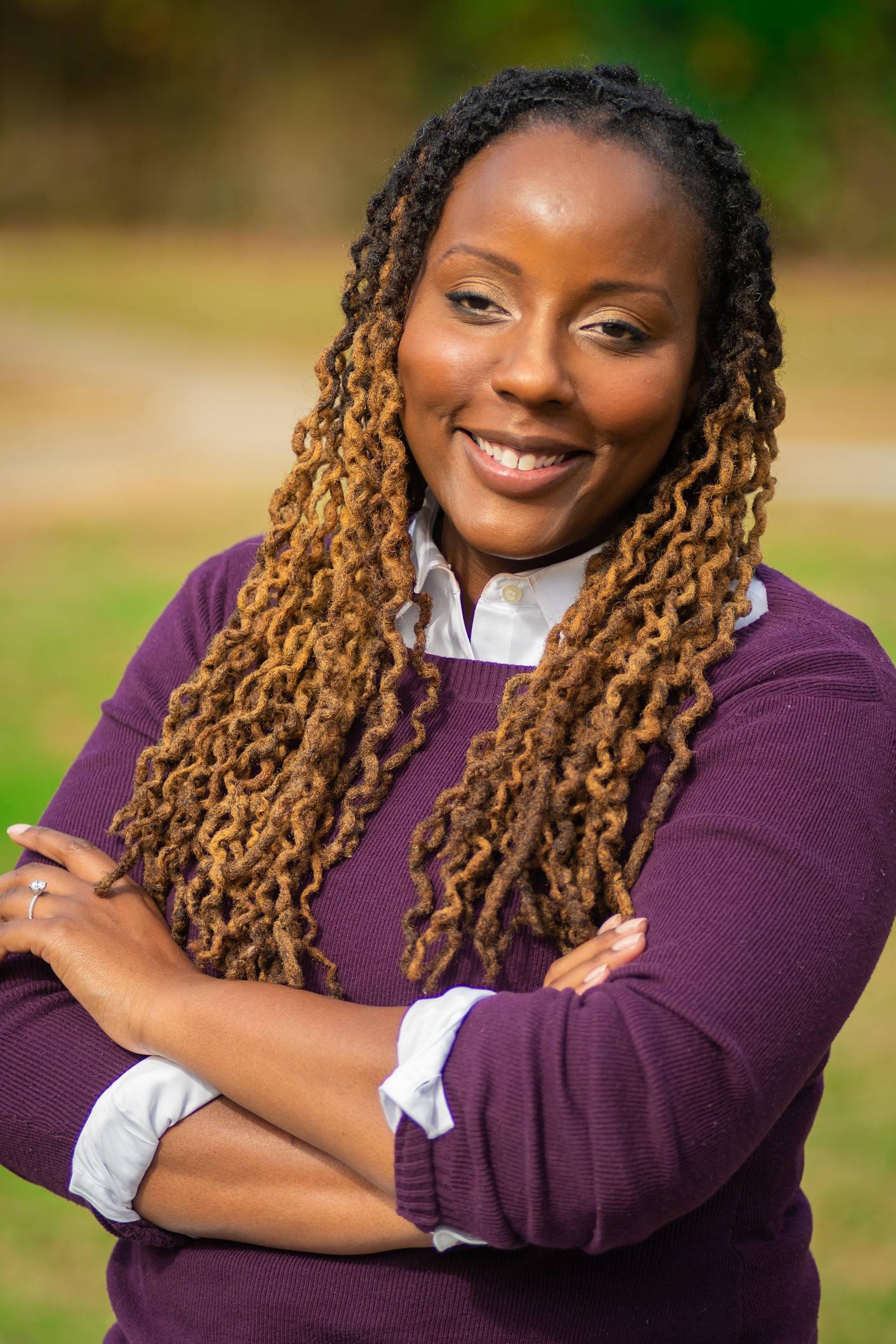
Julia S. Charles
Categories: Creative Scholarship
Fannie Mae extends agreement with Auburn University’s Rural Studio to provide rural housing solutions
Housing finance provider Fannie Mae has extended a research agreement with Auburn University’s Rural Studio program, providing an additional $450,000 to advance The Front Porch Initiative for those in low-income, rural areas.
The contract is under the leadership of principal investigator Rusty Smith and co-principal investigator Mackenzie Stagg. Smith is associate director of Rural Studio and on the faculty at the School of Architecture, Planning and Landscape Architecture, or APLA, where Stagg is an assistant research professor.
Under the terms of the initial two contracts with Fannie Mae, faculty and students from Rural Studio, located in Newbern, Alabama, developed prototype designs and related construction documents for high performance rural homes. The third contract, for $450,000, moves the project from planning to implementation as field-test partners work with The Front Porch Initiative to begin building houses.
Under the guidance of the Federal Housing Finance Agency, Fannie Mae has developed a three-year Duty to Serve plan that seeks creative ways to increase availability of mortgages and housing in low-income, high-needs rural areas.
“This project is about changing the way people look at mortgages and home ownership by linking home performance with financing,” Stagg said.
The partnership is beneficial to both parties: Rural Studio has a 15-year history of developing affordable, high-performance rural homes, and Fannie Mae has the financial expertise to help make them accessible to those in need.
The current phase enables the Rural Studio Front Porch Initiative team to continue to partner with organizations on the ground that are building homes in rural areas. The Front Porch Initiative currently works with organizations in Alabama, Tennessee, Florida and South Carolina.
Additionally, the research contract with Fannie Mae allows the team to offer technical assistance and construction documents to field test partners and home builders.
Rural Studio has refined construction documents and communication, both paper and online, with house-specific instructions. Finally, this contract will enable Rural Studio to develop both quantitative and qualitative analyses of the performance of the energy-efficient homes that are now under construction.
Based on the specific model and owner of each home, the team collects data related to energy consumption, indoor air quality, ambient light, temperature, relative humidity and intra-wall measurements that will then be compared to exterior weather and climate data. Of equal importance is gathering information related to the general experience and relative comfort of people living inside the home.
Fannie Mae’s support of the Front Porch Initiative has been fundamental to receiving other funding, including a recent USDA grant to study rural housing. As the Front Porch Initiative team presses on in its study of affordable rural housing, both partners are finding the collaboration to be fruitful.
“The faculty, staff and students of Rural Studio have been innovative and creative housing partners,” said Michael T. Hernandez, vice president of Housing Access, Disaster Responses and Rebuild Fannie Mae. “Our work with the Front Porch team has resulted in many new actionable learnings on how to design and build affordable and resilient homes to serve the needs of rural communities.
“I applaud their efforts to assist other rural and urban housing providers across the country leverage the knowledge and experience of Rural Studio.”
BY CADC COMMUNICATIONS

A 20K Home recently constructed as part of Auburn University Rural Studio's Front Porch Initiative in partnership with Auburn Opelika Habitat for Humanity. Housing finance provider Fannie Mae has extended a research agreement with the program, providing an additional $450,000 to advance The Front Porch Initiative.
Categories: Creative Scholarship, External Engagement
Smith receives Creative Research and Scholarship Award for research on home affordability
Rusty Smith would be the first one to tell you experience is the greatest teacher. And that’s exactly the model for how Auburn University’s Rural Studio program operates.
“We set up experiences where students can learn the things they need to learn,” said Smith, associate director of Rural Studio and associate professor in the School of Architecture, Planning and Landscape Architecture in Auburn’s College of Architecture, Design and Construction. “That’s really what we do. So to do that, you can’t really take shortcuts. The students have to learn things by experience. So by nature, we have to ask the students to do things that we ourselves don’t know how to do.”
Smith is one of this year’s two recipients of the university’s Faculty Award for Creative Research and Scholarship. The honor acknowledges the research achievements and contributions of faculty who have distinguished themselves through research, scholarly works and creative contributions to their fields.
Although Smith was recognized with the award, he would explain this award also acknowledges the hard work of his students at Rural Studio—which is Auburn’s internationally recognized design-build program for the underserved communities of Alabama’s rural Black Belt region. The program is located in Newbern, Alabama, and gives architecture students hands-on educational experience by partnering with the neighbors in the community to fundraise, define solutions, design and ultimately build remarkable projects.
“It’s important to know that the work done at Rural Studio is the work of students,” said Smith. “It is one of the things that is hard to imagine for many folks when they find that out and see it in action. The students come out and really invest themselves in some of the challenges that our clients, neighbors and community members face in rural America.”
Smith supports his students as they immerse themselves in rural areas while conducting research on home ownership attainability and testing new methods of sustainable homes. Rural Studio has designed and constructed more than 200 projects and educated more than 900 citizen architects.
In previous years, the Rural Studio was known for establishing an ethos of recycling, reusing and remaking. However, the studio’s scope and complexity of its projects to include the design and construction of community-oriented infrastructure, the development of more broadly-attainable small home affordability solutions and a comprehensive approach to addressing insecurity issues relative to income, energy, food, health and education sources has broadened over the past decade.
Its philosophy is that everyone, both rich and poor, deserves the benefit of good, dignified design. The studio continually questions what should be built, rather than what can be built. Smith applies this philosophy by creating experiences for students to address specific community needs and people needs.
Smith’s creative approach to teaching through experiences provides students the opportunity to invest themselves in the immediate needs and deeply complex challenges of rural America.
“The thing that becomes most memorable in that interaction with students is that they come to faculty members and say ‘how do I do this?’” said Smith. “You look at them and you say ‘I don’t know.’ They get nervous because it is not what they’re used to a faculty member saying, but then we roll up our sleeves and we figure it out together. Those are the moments that are the most memorable and important to me as a teacher. It’s rolling up our sleeves and learning how to do things together.”
Smith is a nationally recognized teacher and scholar who was educated at Auburn University and the School of the Art Institute of Chicago. He recently received the American Institute of Architects' National Teaching Honor Award and the American Institute of Architecture Students' National Teaching Honor Award.
BY SUSIE BRIDGES
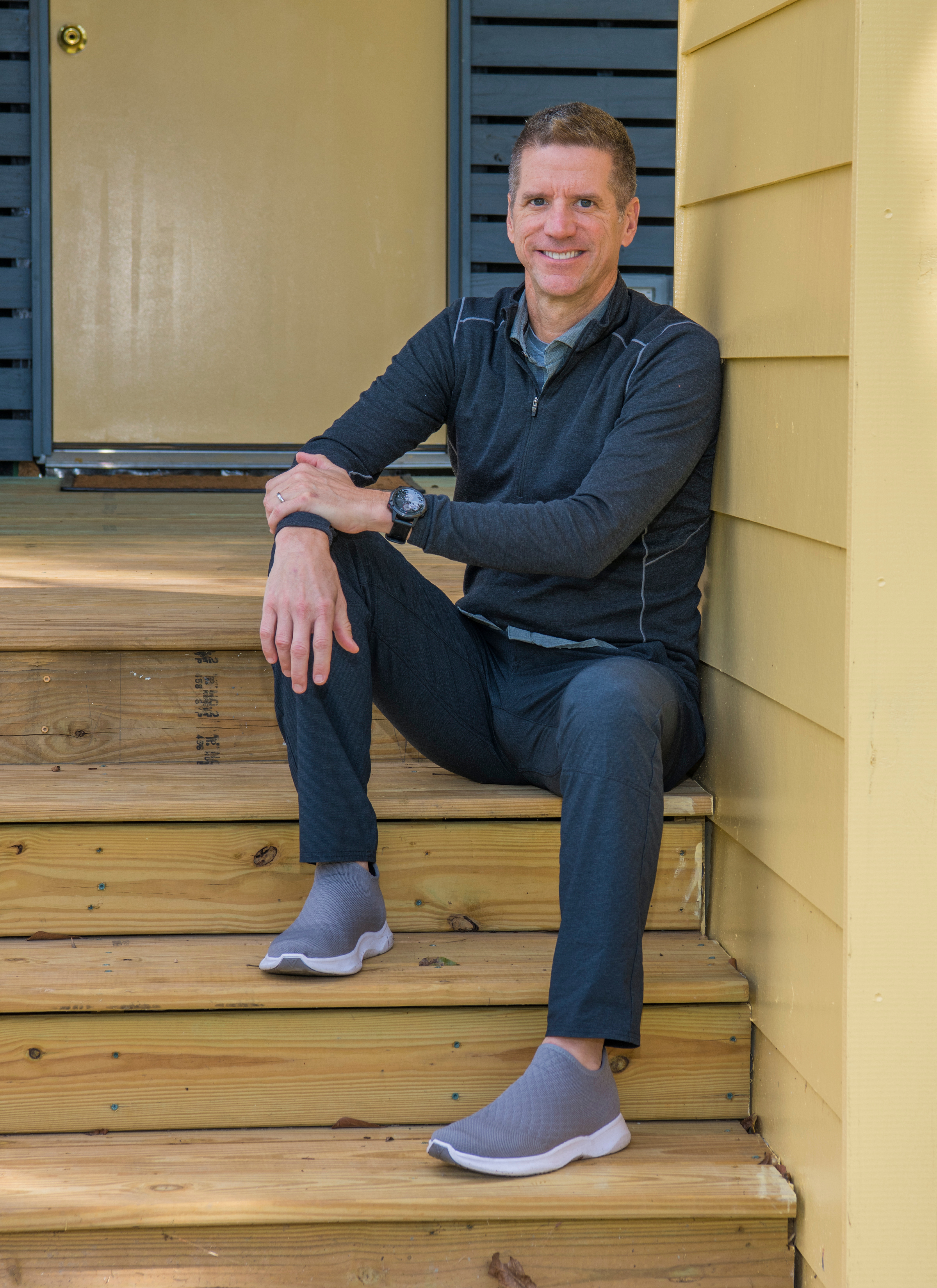 Rusty Smith, associate director of Rural Studio and associate professor in the School of Architecture, Planning and Landscape Architecture in Auburn’s College of Architecture, Design and Construction, is one of two recent recipients of Auburn University’s Faculty Award for Creative Research and Scholarship.
Rusty Smith, associate director of Rural Studio and associate professor in the School of Architecture, Planning and Landscape Architecture in Auburn’s College of Architecture, Design and Construction, is one of two recent recipients of Auburn University’s Faculty Award for Creative Research and Scholarship.
Categories: Creative Scholarship, Energy & the Environment, External Engagement
Nearly 600 Auburn students showcasing their research and creativity April 9 at Auburn Research Student Symposium
Nearly 600 Auburn University students with a flair for research and creativity will showcase their talents when they gather for the annual Auburn Research Student Symposium.
With projects ranging from chemical engineering to plant pathology to architecture and design, the symposium on April 9 will provide Auburn and Auburn Montgomery students an opportunity to share their discoveries university-wide. The daylong event will take place in the Student Center.
Undergraduate and graduate students from almost every department have registered to participate through posters, oral presentations and creative scholarship displays. Approximately 400 of the young researchers will present posters and displays more than 180 will give 10-minute talks, all under the watchful eyes of judges who will award top honors in a variety of university-wide and college-specific categories.
An awards ceremony and reception will be held April 18 at 5 p.m. in the Student Center ballroom. The keynote speaker will be Michael Zabala, assistant professor of mechanical engineering, who earned his bachelor’s degree at Auburn in 2007.
Steve Taylor, chair of the Research Symposia Committee and associate dean for research in the Samuel Ginn College of Engineering, said, “Our students’ innovative research covers many areas, from projects in STEM disciplines [science, technology, engineering and mathematics] to the arts and humanities. They are working with our world-class faculty on life-changing projects that could shape new developments in many fields.”
Following the April 9 symposium, Nobel Laureate in Chemistry George P. Smith will visit Auburn University and the College of Veterinary Medicine April 10-11. Professor Smith will present a public lecture at 2 p.m. April 10 in The Hotel at Auburn University and Dixon Conference Center auditorium, which will be followed by a reception. On April 11, he will be available to meet with faculty and students at the College of Veterinary Medicine.
A fall event, the Auburn Research Faculty Symposium, will be held in September to recognize faculty excellence in research and creative scholarship.
More information about the student symposium is available at www.aub.ie/researchstudentsymposium or by contacting Taylor at taylost@auburn.edu.
WRITTEN BY CHARLES MARTIN

Auburn students with a flair for research and creativity will showcase their talents when they gather April 9 in the Student Center for the annual Auburn Research Student Symposium. Pictured, student Elizabeth Bankston discusses her research poster with Steve Taylor, chair of the Research Symposia Committee, at last year’s symposium.
Categories: Creative Scholarship, Cyber, Energy & the Environment, Health Sciences, Transportation, Food Systems, Security, Engineering
Auburn University achieves research milestone with ‘R1’ Carnegie classification
In another affirmation of its drive forward to excellence, Auburn University achieved a research milestone Monday - being elevated to an “R1” institution by the Carnegie Classification of Institutions of Higher Education.
The announcement follows a concerted effort by Auburn to elevate its commitment to life-saving research, beginning with an announcement by Auburn President Steven Leath in December 2017 and subsequent awarding of $5 million for three years toward the Presidential Awards for Interdisciplinary Research, or PAIR. An R1 designation by Carnegie is reserved for doctoral universities with the highest levels of research activity.
Among 120 institutions to receive the R1 designation Monday, Auburn was listed in the top 100 of such universities, raising its classification from an already lofty “high research” R2 classification to Monday's “very high research activity” R1 label.
“This tremendous designation acknowledges the hard work involved in the pioneering discoveries happening at Auburn every day,” said Leath, who was recently named one of seven new members appointed by President Trump to the National Science Board, a policy-making body of the National Science Foundation. “We are grateful to the university’s faculty and staff, especially Graduate School Dean George Flowers, for their unwavering commitment to elevating Auburn’s profile as a world-class academic institution.
“Auburn is on the move, and this prestigious distinction recognizes Auburn’s critical role in creating new knowledge and helping others live better lives.”
Universities considered for the R1 designation must have awarded at least 20 research/scholarship doctoral degrees and had at least $5 million in total research expenditures, according to Carnegie’s classification website. Auburn has grown its research efforts in both STEM and non-STEM areas, furthering its institutional commitment to offer solutions to real-world problems and grow its reputation as a go-to university in providing results that transform and inspire.
“Auburn University is known for its innovative and transformational research, and receiving the R1 classification is a significant accomplishment,” said Jennifer Kerpelman, interim vice president for research. “This classification recognizes the dedication, commitment and hard work of Auburn’s faculty and student researchers across all disciplines.”
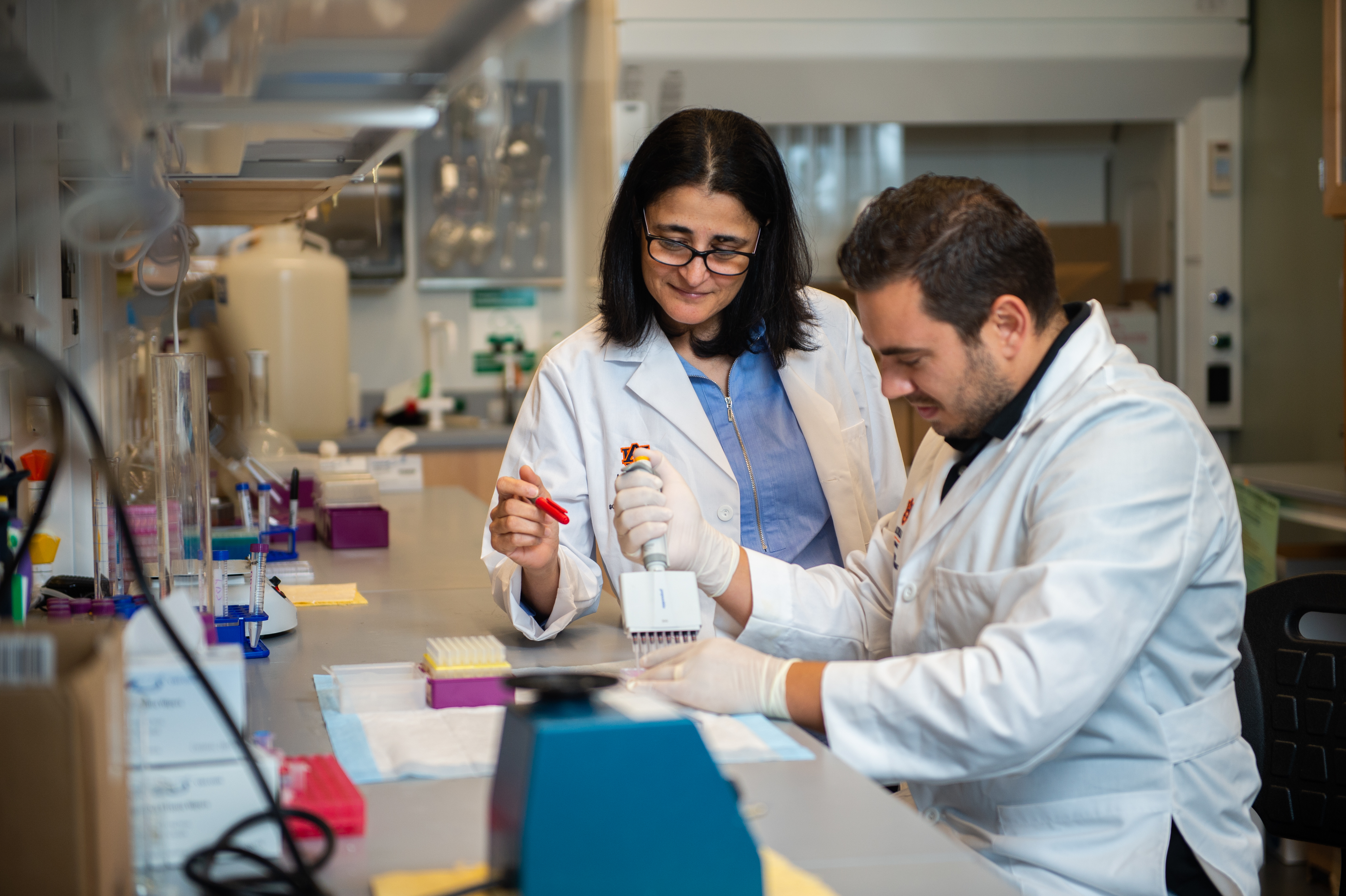
Dr. Amal Kaddoumi, left, a professor in Auburn’s Department of Drug Discovery and Development, works in a lab with graduate research assistant Sweilem Al Rihani. Kaddoumi is leading a multi-disciplinary team in an investigation of oleocanthal, a molecule that appears naturally in extra-virgin olive oil, as a novel preventative treatment for such diseases as Alzheimer’s or dementia.
Categories: Creative Scholarship, Cyber, Energy & the Environment, Health Sciences, Science, Technology, Engineering and Mathematics (STEM), Transportation, Food Systems, Engineering, Auburn In the News
SHOWCASE features creative scholarship from 22 departments across campus
“SHOWCASE: The Work of Creative Scholarship” opened Friday and runs through Oct. 14 at the Jule Collins Smith Museum of Fine Art, highlighting the creative work of Auburn University faculty, staff and students. The multidisciplinary exhibition features fine art, applied art and design, performing arts, creative writing and other work from 22 departments across eight of Auburn’s colleges. The exhibition is held in conjunction with the Auburn Research Faculty Symposium, which follows Oct. 23 in the Auburn University Student Center.

Auburn artists whose works are displayed include, from left, Jack Stoffel, theatre student; Annie Campbell, art professor; and Fereshteh Rostampour, event organizer and professor of lighting and set design. (Photo by Charles Martin)
Categories: Creative Scholarship


